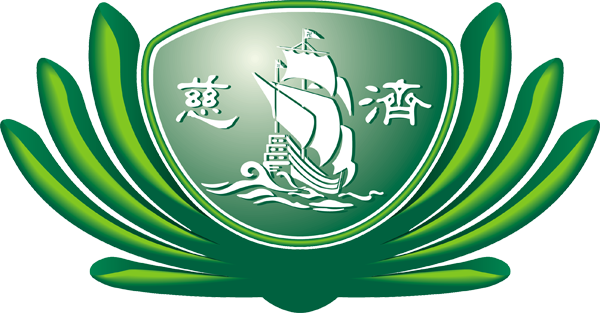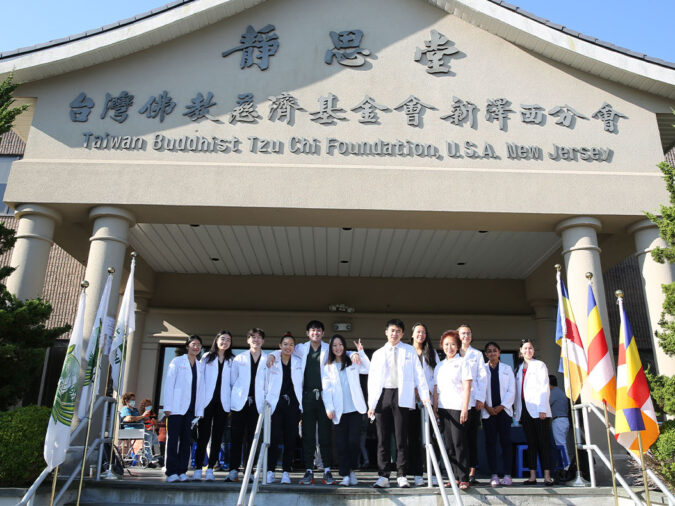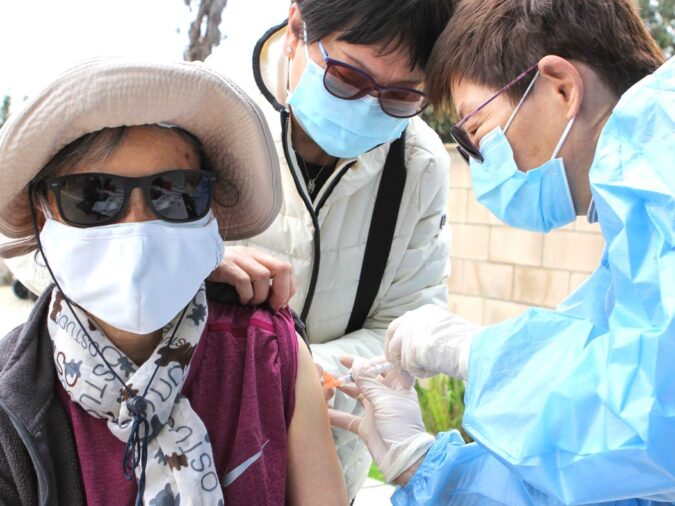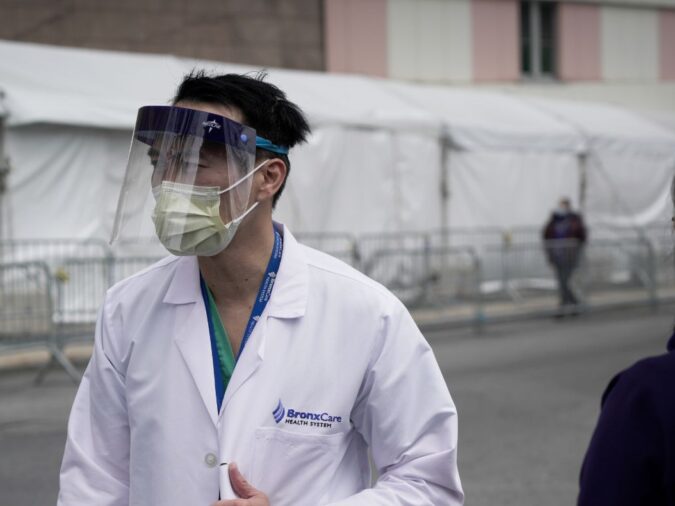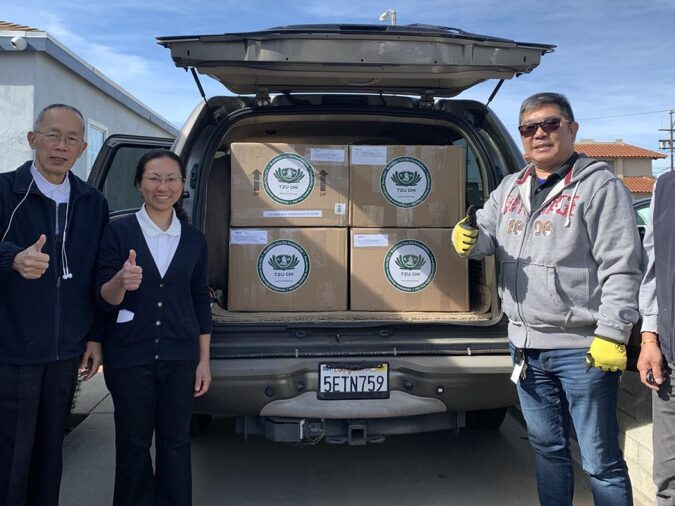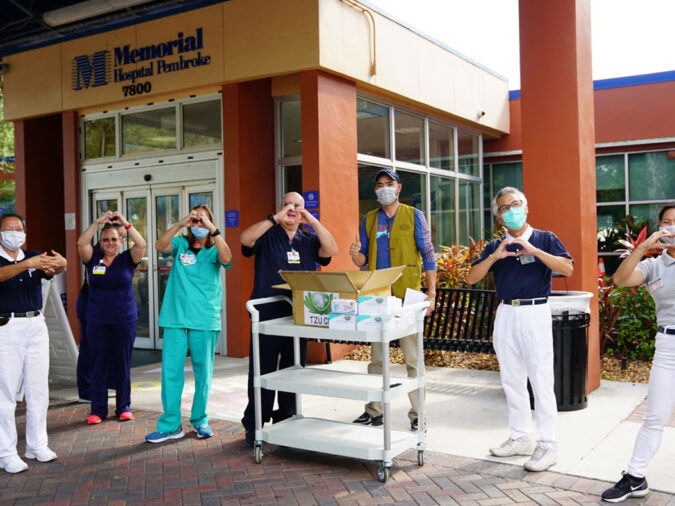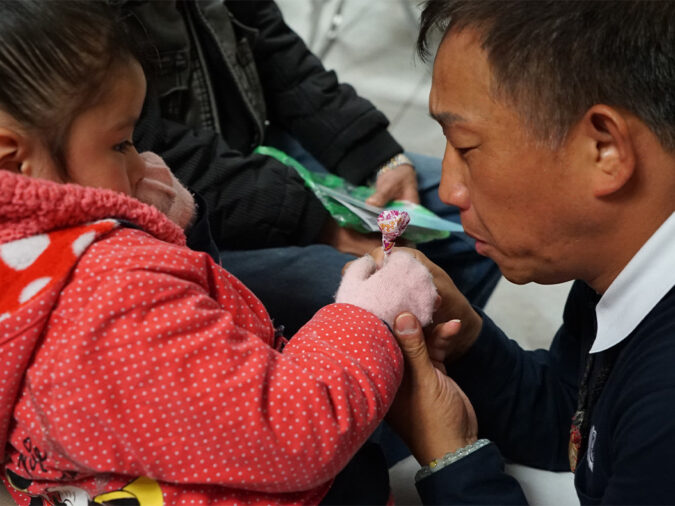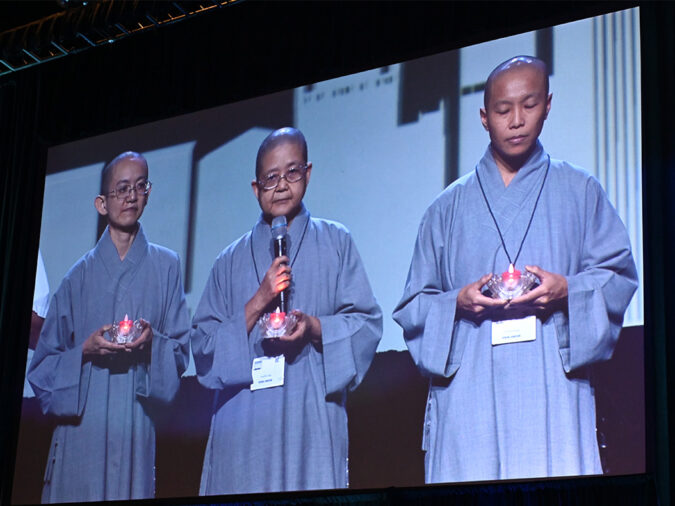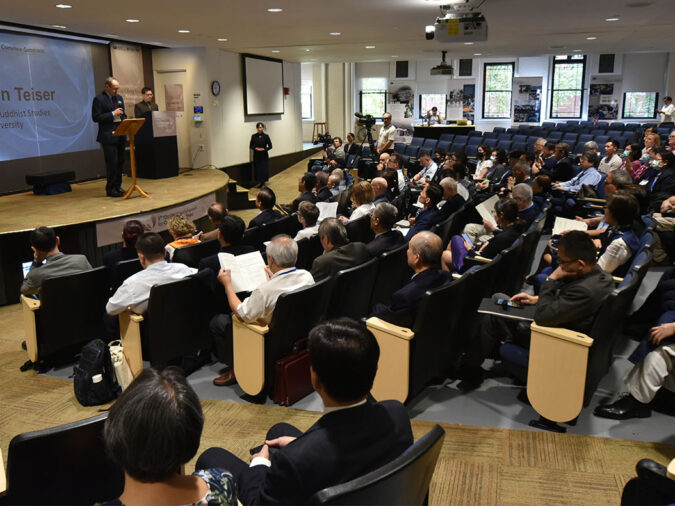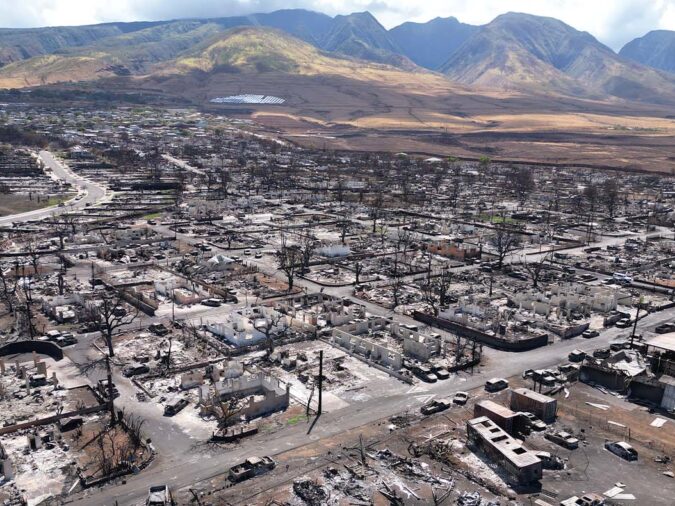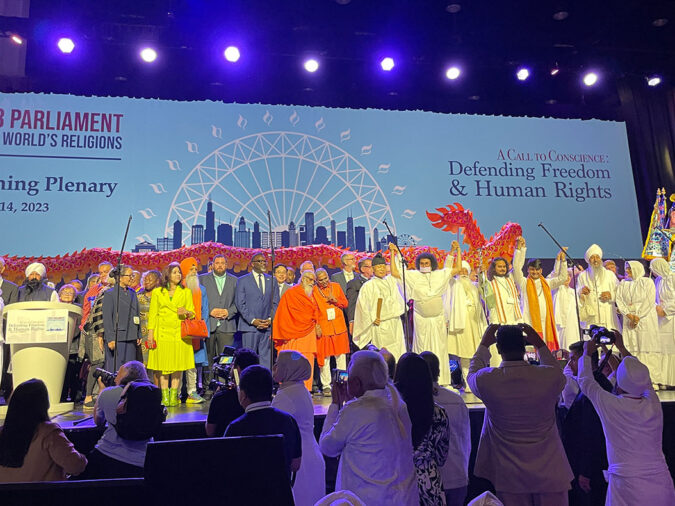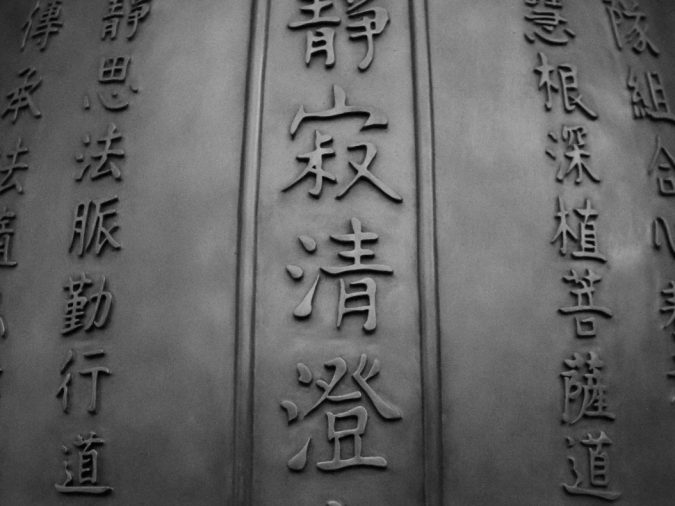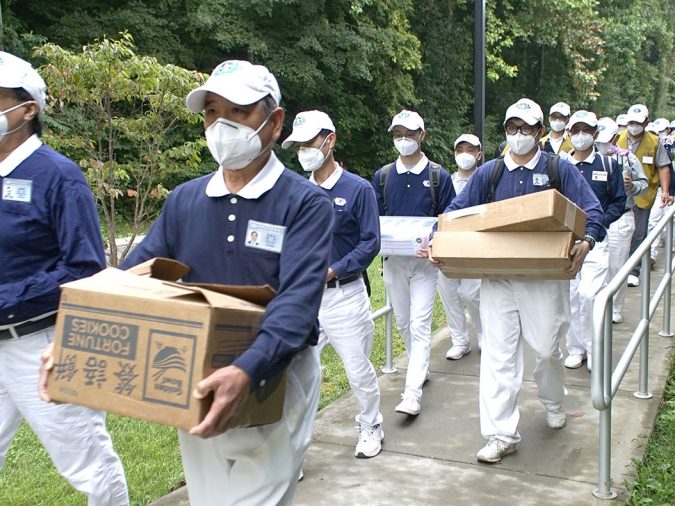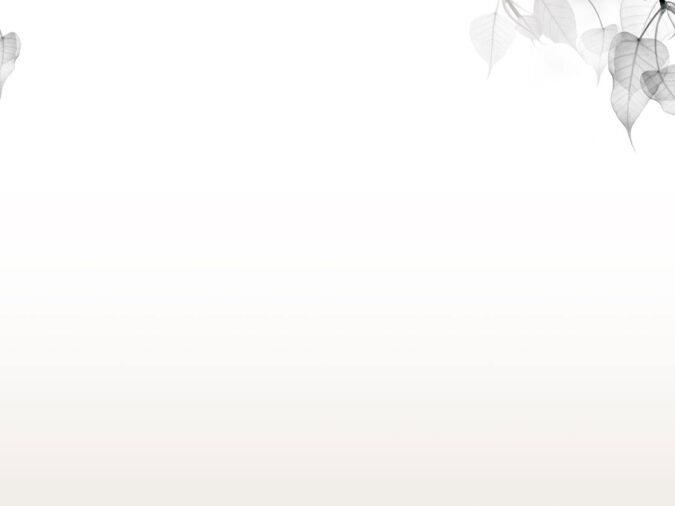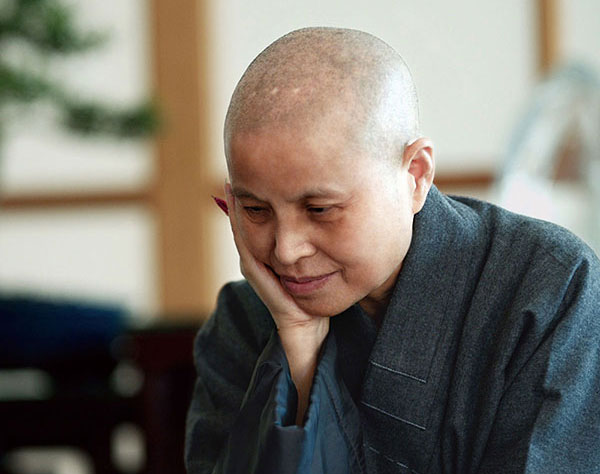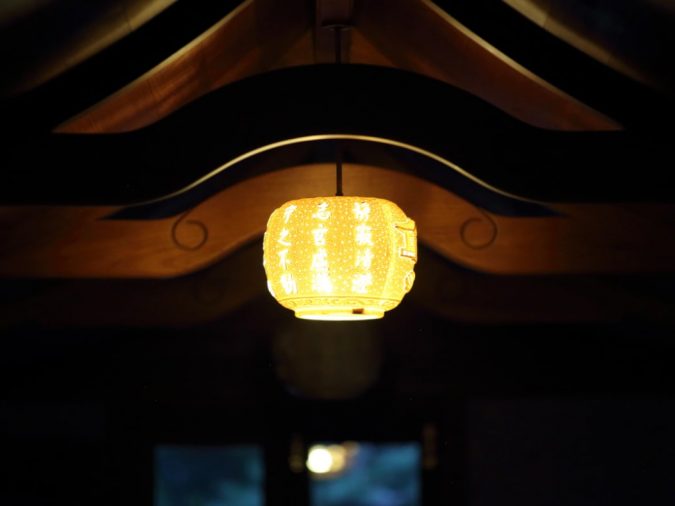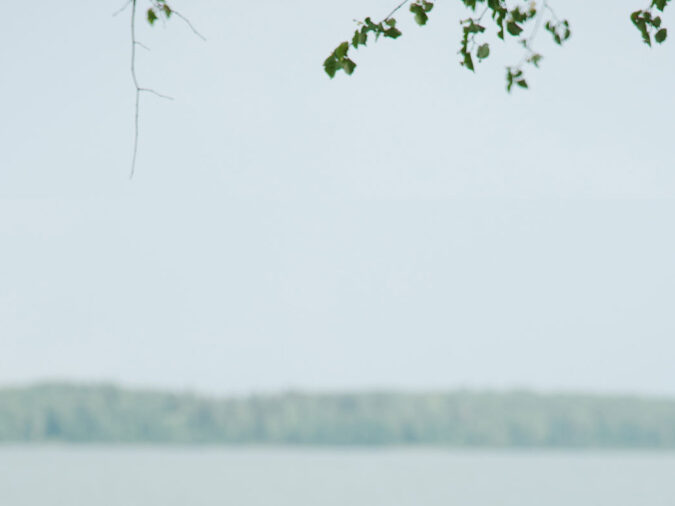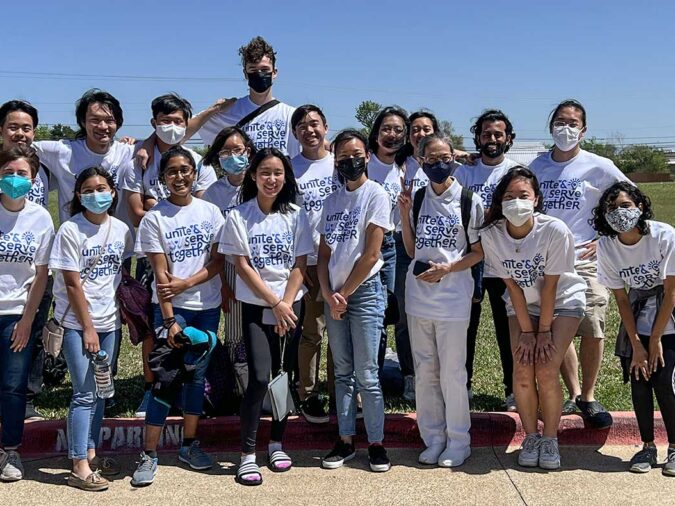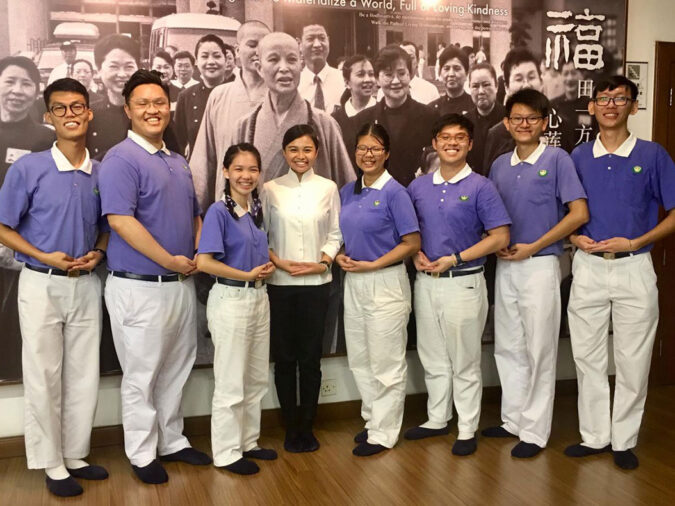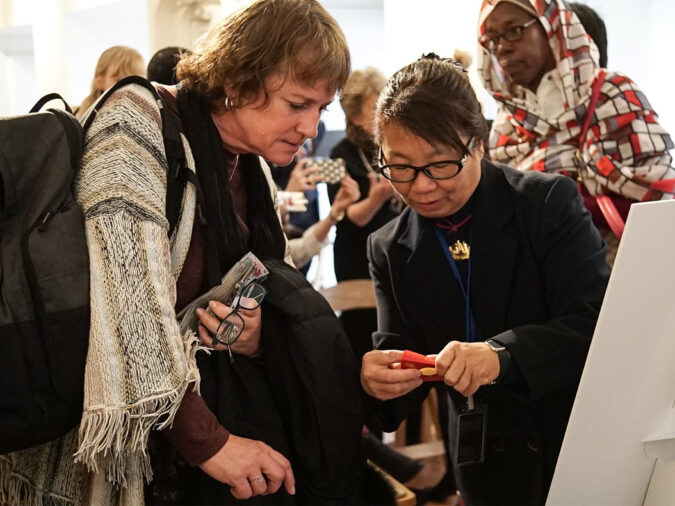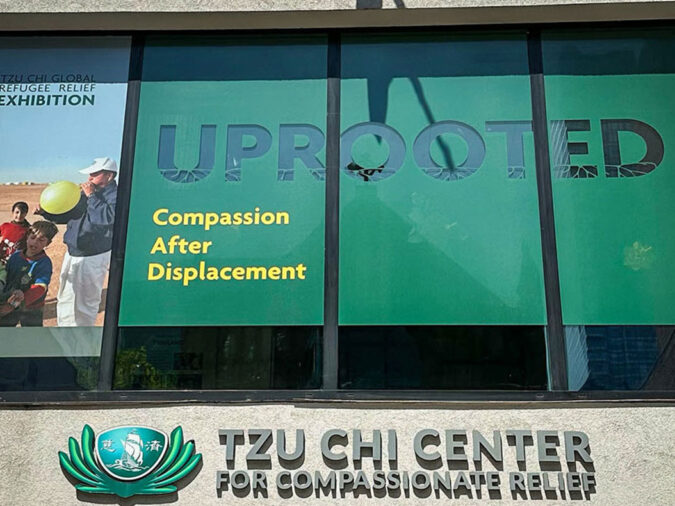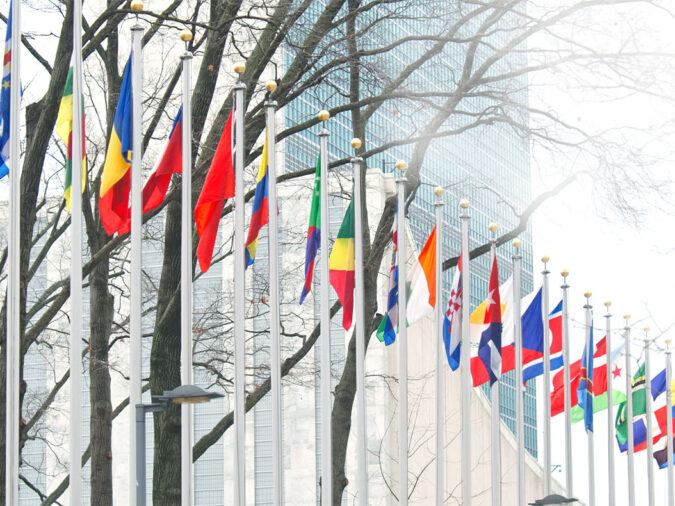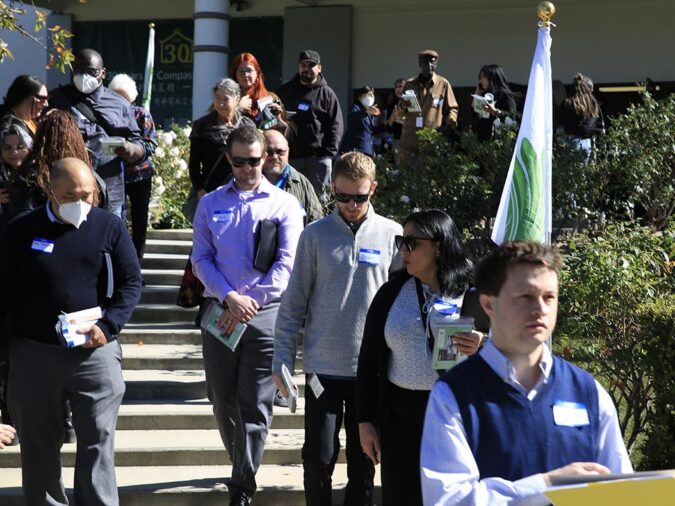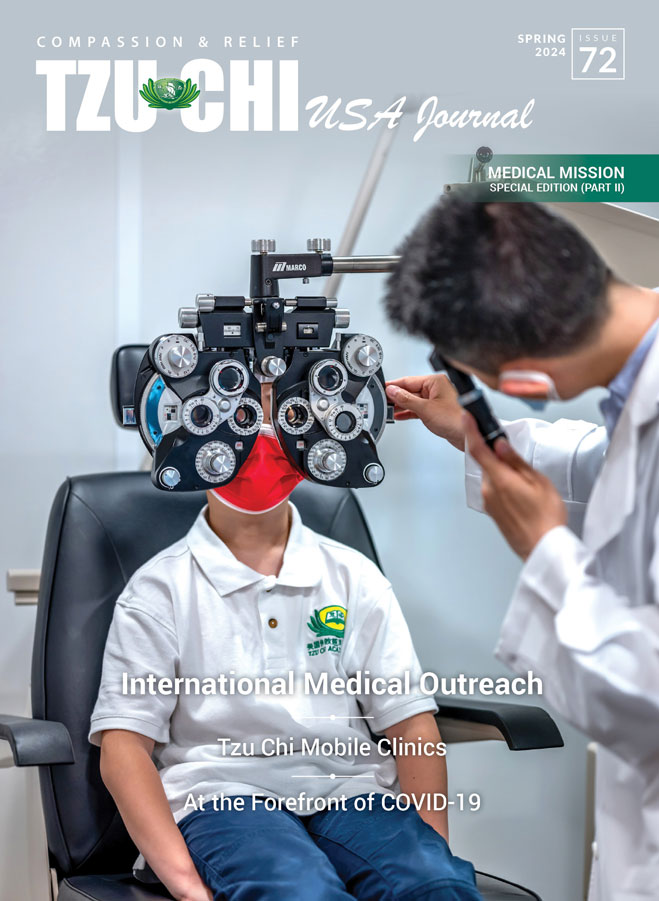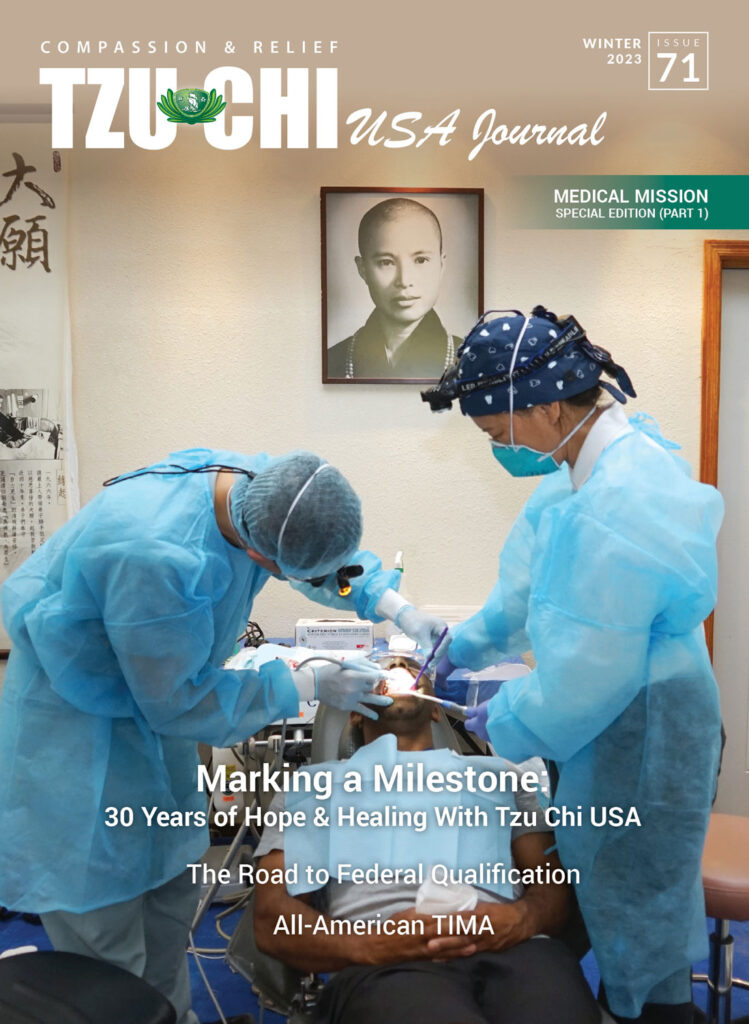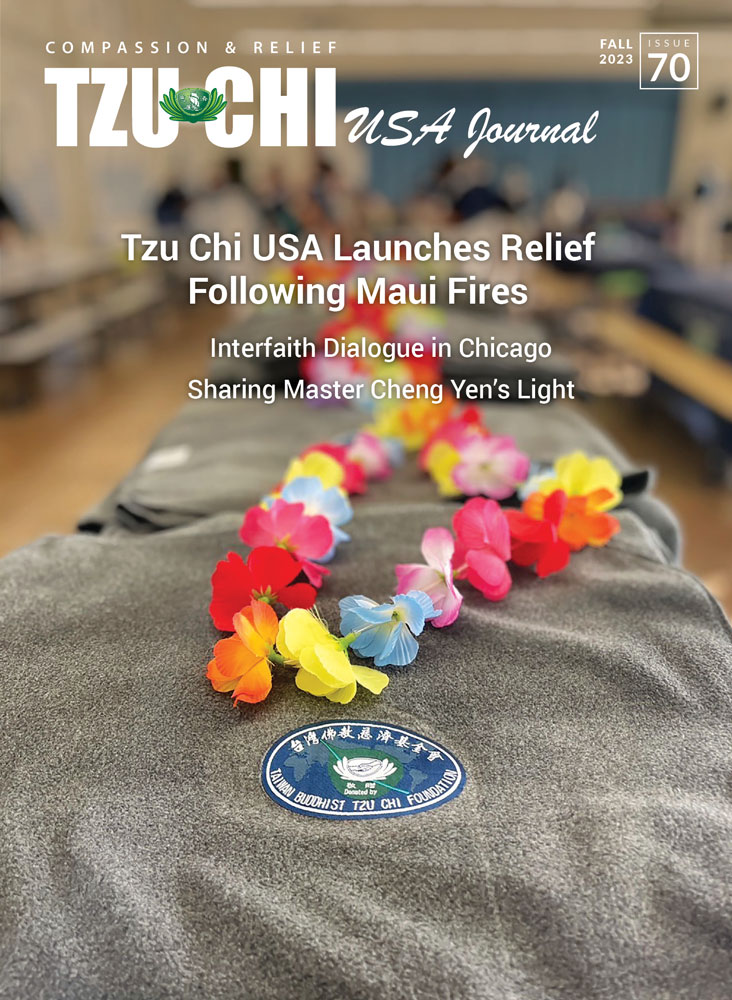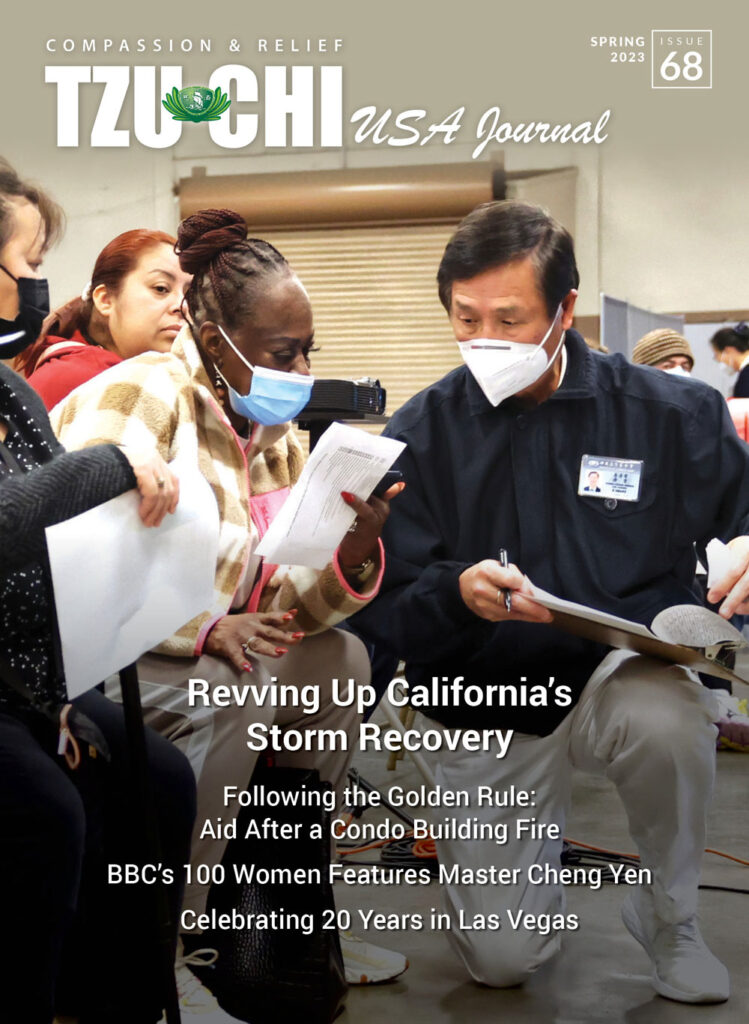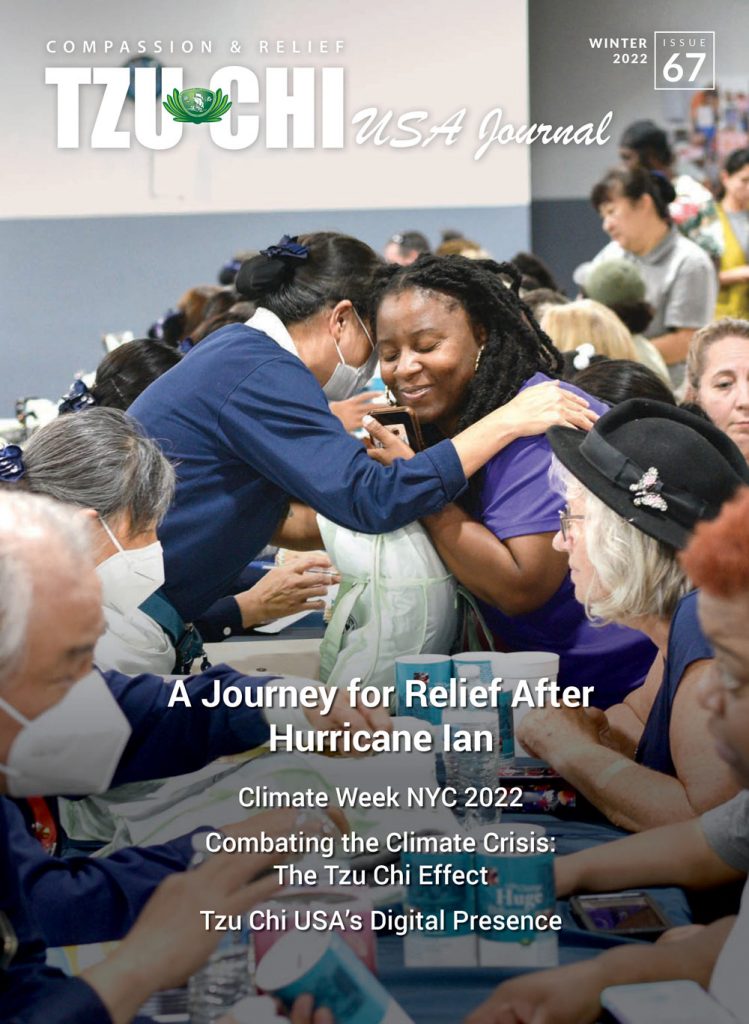CHAPTER 1
Marking a Milestone
30 Years of hope & Healing With Tzu Chi USA
Chapter 1 – Marking a Milestone: 30 Years of Hope & Healing With Tzu Chi USA
Written by Adriana DiBenedetto and Pheel Wang
Published #71 | Winter 2024 Issue
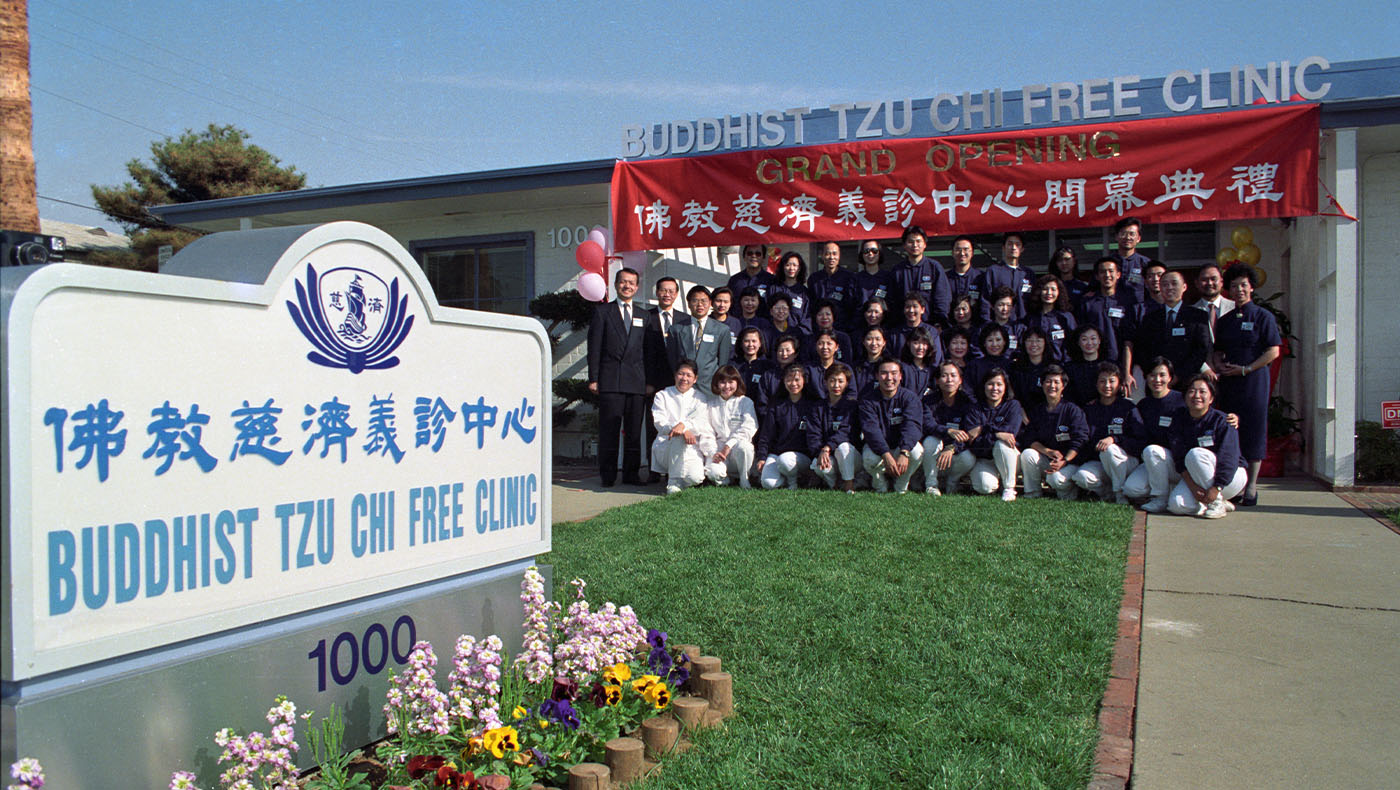
Tzu Chi’s medical mission travels across the ocean from Taiwan to the United States to address healthcare coverage gaps. On November 1, 1993, the Buddhist Tzu Chi Free Clinic opens in Alhambra, California, providing free medical care to underserved patients. Photo/Jinyi Huang
SHARE
We should always do the best we can to help others, even if we can only contribute a little. If we pool all of our efforts, we can help a lot of people.
Dharma Master Cheng Yen
The United States healthcare industry is ever-evolving, yet the scope of care does not reach all, and the financial strain is looming for many people.
The efficient and compassionate delivery of health services is essential to protecting the well-being and dignity of all, as well as a catalyst for equality, prosperous and sustainable societies, committing to zero hunger, and beyond. However, even when health care is available, it may fail to cover the full spectrum of human needs. Thus, this gap gives way to exclusionary or catastrophic healthcare expenses.
Section 1
Tzu Chi’s Medical Mission at a Glance
The Buddhist Tzu Chi Free Clinic was registered on December 28, 1993, as a 501(c)(3) charitable non-profit organization that provides holistic and integrated healthcare services, alongside Tzu Chi outreach, group support programs, and preventive health education — all at no cost. This means providing affordable healthcare options for all those in need, as well as creating safe, warm, and multilingual environments for each and every Tzu Chi clinic service and outreach event. A little over one decade later, on August 3, 2005, the free clinic adjusted its name to Taiwan Buddhist Tzu Chi Medical Foundation as it reached another milestone for the medical mission. And, following a Board of Directors decision to remove “Taiwan” from the title, its name was again revised to the Buddhist Tzu Chi Medical Foundation as of December 17, 2009, reaffirming its commitment to providing fair and impartial care to people of all ethnicities and cultural backgrounds.
In the midst of it all, the Tzu Chi Taiwan Medical Professional Association was founded in 1996 to serve as a home and network for all Tzu Chi medical volunteers. With international medical outreach as a focus, the mission expanded again with the Tzu Chi International Medical Association in 1998.
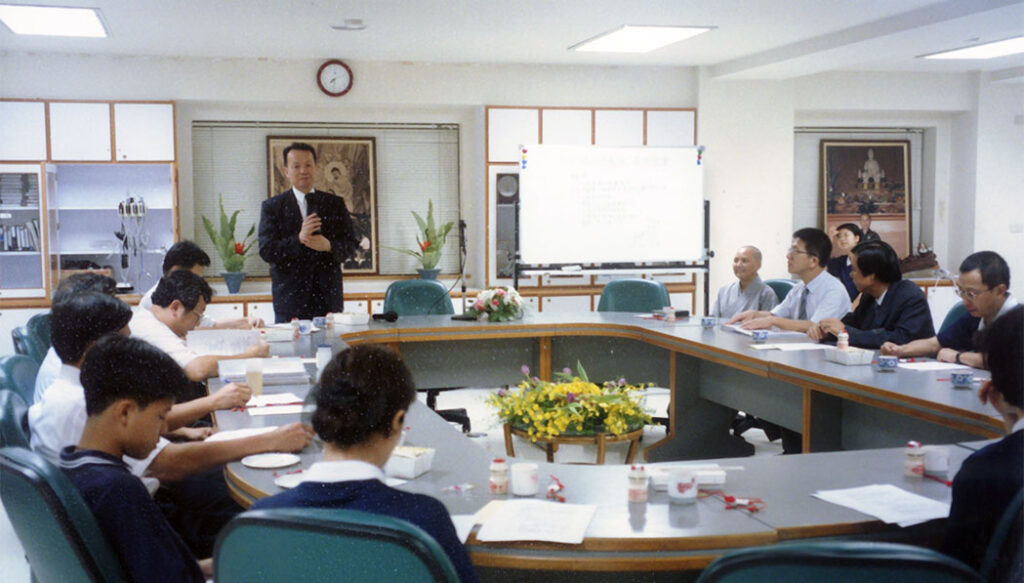
The Establishment and Philosophy of the Tzu Chi International Medical Association
With the medical mission flourishing in Taiwan and beyond, the Tzu Chi Taiwan Medical Professional Association invited medical professionals both from Taiwan and overseas who share Tzu Chi’s medical philosophy to gather in Taipei on October 12, 1996. Together, they exchanged valuable volunteer experiences with one another. With the gradual expansion of the scale of free surgical clinics in the Philippines and the establishment of the Buddhist Tzu Chi Free Clinic in Alhambra, California, Dr. Zhengcheng Chen of Hawaii proposed the establishment of a medical professional association unifying Tzu Chi medical volunteer personnel around the globe. The proposal was endorsed and responded to by physicians from the United States, the Philippines, and Taiwan, who share the same vision. Stephen Huang, the then CEO of Tzu Chi USA, emphasized that the operation of this medical network should be closely integrated with Tzu Chi’s international relief operations. Dharma Master Cheng Yen formally named the organization Tzu Chi Medical Association on January 18, 1998, with its concept bringing together caring doctors and related medical personnel from around the world. They mindfully selected key sites with the coordination of the Tzu Chi Foundation to establish the free clinic experience far and wide, and support each other with compassion.
Tzu Chi physicians and experts from Taiwan, the Philippines, and the United States gathered at Tzu Chi’s Hawaii Service Center on April 4, 1998, to participate in the preparatory meeting about the establishment of an international Tzu Chi Medical Association network, offering their ideas for the implementation of this grand concept.
Present at the meeting was Stephen Huang, then CEO of Tzu Chi USA, Dr. Chinlon Lin, then Vice President of Tzu Chi Hualien Hospital and former Director of the Tzu Chi Free Clinic in Alhambra, Mingchang Hsu, then Director of the Tzu Chi Volunteer Center in Alhambra, and Debra Boudreaux, current CEO of Tzu Chi USA, Administrative and Medical Team head, and head of the volunteer team for the Tzu Chi Free Clinic, alongside more than ten Tzu Chi doctors and experts from Taiwan and the Philippines. Dr. Chinlon Lin chaired the meeting.
Everyone was determined to set up what would be called the Tzu Chi International Medical Association (TIMA), a global network of Tzu Chi’s steadfast medical professionals. Together, they provided suggestions for implementing this vision of internationalizing the medical mission. It was ultimately decided to establish the global Tzu Chi Medical network and conduct in-depth research on relevant laws, organizations, operations, and other specific issues. Four locations were also tentatively identified: The USA’s Eastern and Western Regions, Hawaii, and the Philippines. Regional TIMA chapters were immediately established by the Tzu Chi Free Clinic in Alhambra and the Hawaii Branch.
On October 31 of the same year, the TIMA Forum was held in Los Angeles, California, with the participation of more than 60 physicians from multiple countries, including Taiwan, Vietnam, the Philippines, and the United States. The Forum reviewed proposals for TIMA’s Articles of Incorporation and strengthened its position:
(1.) It shall be a volunteer organization affiliated with local branches and a subsidiary unit of the medical mission encompassing Tzu Chi’s four major missions of Charity, Medical, Education, and Humanistic Culture.
(2.) Each region shall have a convenor who shall be a professional member and a director general who shall be a non-professional member.
(3.) Members shall be composed of professional members who are licensed to practice, such as physicians, dentists, pharmacists, nurse practitioners, Traditional Chinese Medicine (TCM) practitioners, laboratory technicians, dietitians, and non-professional members, who are responsible for liaisons, catering, transportation, and other administrative affairs.
TIMA held its first annual meeting in 2000. The organization officially announced its establishment and provided channels for caring medical professionals to contribute their expertise and extend their medical network to all places in need. As an international volunteer clinic organization, TIMA is present in more than 50 countries and regions around the world, and has benefited approximately three million patients (as of July 2019).
To this day, TIMA’s patient-focused medical professional and logistical volunteers in the U.S. continue their service alongside permanent clinics in Alhambra, South El Monte, and Wilmington, California, lifting up access to crucial services, information, and preventive health education offered with compassion. Whenever disaster strikes, TIMA joins Tzu Chi in relief work, providing essential medical support with a unified priority on their patients’ health.
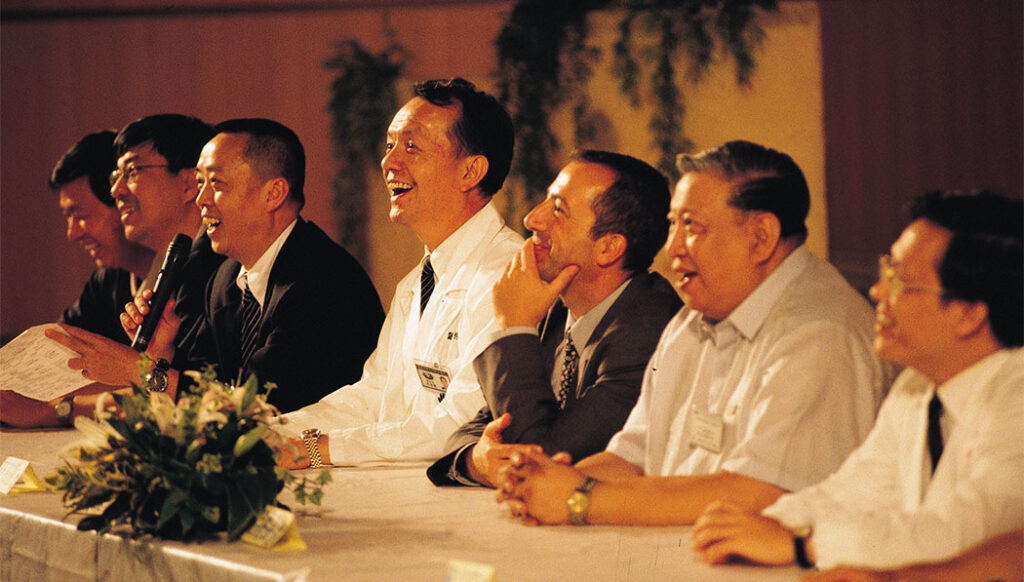
In the United States, TIMA includes health education within its outreach. Due to different needs and regulations across regions, each chapter has a distinct service focus. Although this focus may vary, the desire to ease suffering always remains the same. Indeed, TIMA’s strength reaches beyond the goodwill and devotion of its members. This is because, other than medical aid, TIMA also focuses on spiritual recovery, healing patients from both physical and emotional pain, and revealing paths to new opportunities thanks to improved health. As such, the humanity TIMA imbues into its practice shines a light around every corner of one’s health journey, safeguarding life, health, and love.
Section 2
But How Did It All Begin?
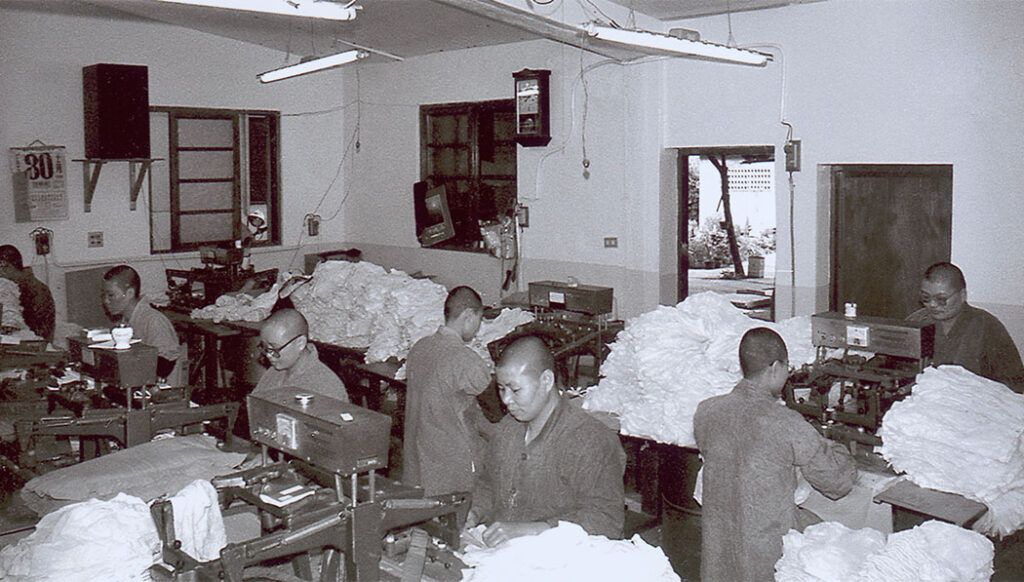
At the heart of it all stands one woman.
In February of 1966, Tzu Chi’s founder, Dharma Master Cheng Yen, then a nun in her twenties, visited a disciple’s father who had recently undergone an operation at a private medical clinic in Fenglin, in central Hualien County, Taiwan.
Upon saying farewell for the time, she was struck by the sight of blood and quickly inquired about what occurred. The medical clinic’s staff relayed a horrible tragedy. They explained how a woman experiencing labor complications had presented to the clinic in urgent need of care to save her baby following an exhausting eight-hour journey. However, she was turned away — unable to provide the security deposit.
Stunned and heartbroken, Master Cheng Yen knew she had to do something. Joined by her disciples, she set aside funds over one year to raise the amount needed for someone, like that woman, to receive the treatment they need and so deserve. Together, her followers, 30 housewives, put small change into a bamboo tube each day before purchasing any food for themselves, whilst crafting baby shoes to sell.
Reflecting on philosophical conversations she’d had with three Catholic nuns who taught at a missionary school in Hualien, Dharma Master Cheng Yen shared another realization: “I spoke about Buddhism, and they spoke about Catholicism; we had a great conversation. After discussing the religious doctrines with each other, the three nuns suddenly asked, ‘The Buddha promotes compassion. Have you done anything for society?’ At that time, I was speechless, but I was eager to protect the Dharma.” These words further inspired her faith and perseverance, holding the genuine belief that human beings have unlimited potential, especially when joining hands for a good cause.
And so, on a chilly January morning in 1983, a group of nuns and housewives carrying tools gathered in a field in Hualien. Their goal: Clear a space where a new hospital would one day stand.
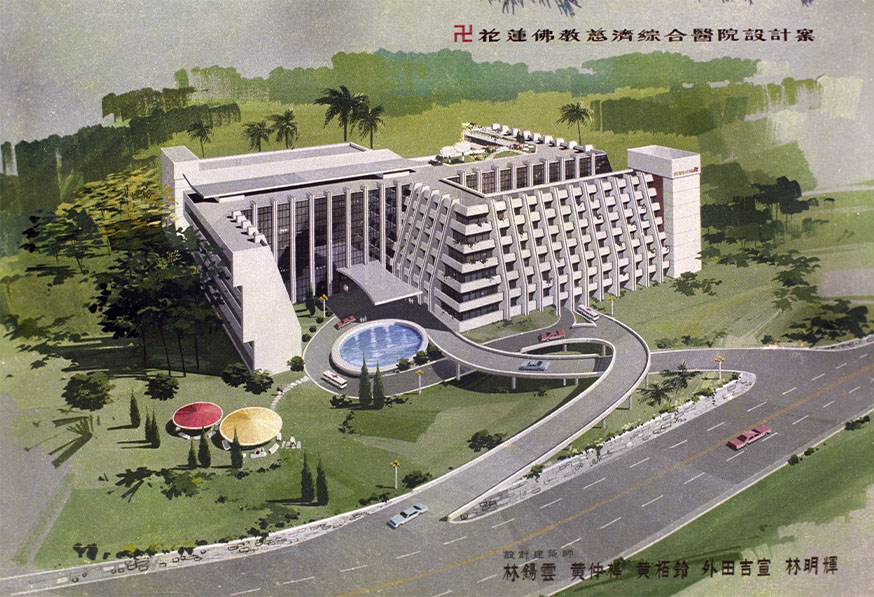
Once dismissed as a daydream, the Tzu Chi General Hospital was inaugurated in 1986, and built for approximately NTD$80 million. In addition to exempting patients from hospitalization deposits, the hospital also assisted disadvantaged patients in seeking social assistance, thus transforming the eastern portion of the island of Taiwan from what was once seen as a medical desert into an oasis.
The Buddhist Tzu Chi Foundation’s footprint of charity and humanitarianism now spans the globe. To this day, Tzu Chi continues to use a symbolic iteration of these bamboo tubes — the Foundation’s signature bamboo banks — as an everlasting reminder of this noble act.
Tzu Chi’s life-saving medical missions, carried out by a team of medical professionals, volunteers, and staff members passionate about helping others, deliver free medical care, dental care, eye exams, and more — addressing the health concerns of those most in need where access to meaningful medical care often is not available to them.
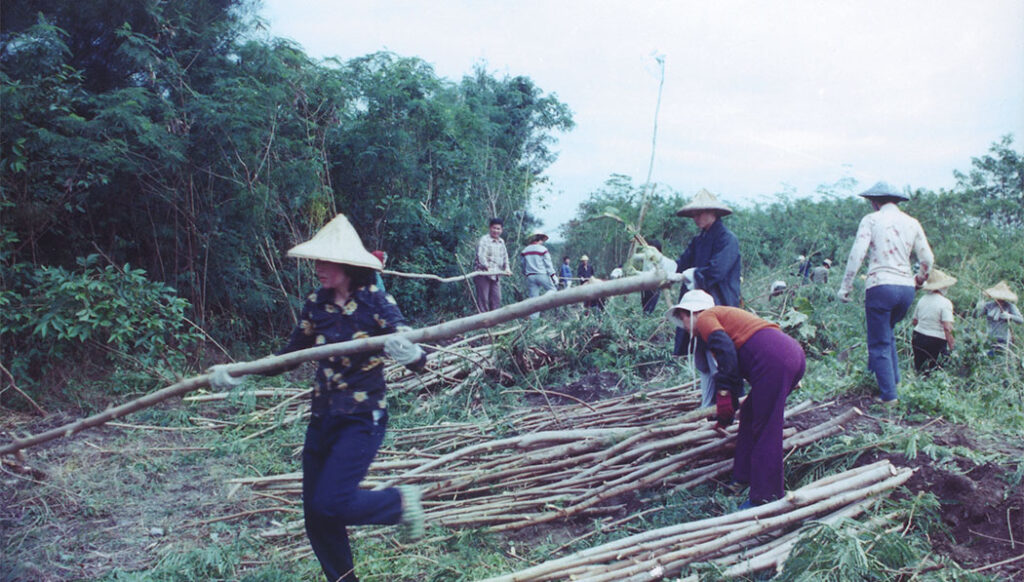
Section 3
A Journey Back in Time
The first major leap in healthcare reform within the United States was the Social Security Act of 1935, which aimed to facilitate adequate provisions for older adults, maternal and child welfare, public health, and more. A few short years later, in 1939, the first official Blue Shield plan was designed to help America’s workers cover the costs of physician care. Yet, it was not until the 1960s that the government began to take a more active role in health care.
In 1965, Medicare and Medicaid programs were established to strengthen health care for older adults, people with disabilities, and people from low-income and underserved communities. Even so, in 1997, the Census Bureau’s Current Population Survey estimated that 42.4 million people in the United States were uninsured. By 2007, the Census Bureau estimated the number of uninsured people to have increased to 45.6 million.
Over the years, the Affordable Care Act (ACA) coverage expansions, including the Medicaid expansion to low-income adults, have helped reduce disparities in coverage and boosted positive health outcomes. Despite the triumph of the ACA’s implementation in 2010, in 2021, 64% of uninsured adults said that they were uninsured because the cost of coverage was still prohibitively expensive. And, one in five uninsured adults in 2021 went without needed medical care due to cost.
According to the Centers for Disease Control and Prevention’s National Center for Health Statistics, 27.6 million Americans of all ages still did not have health insurance as of 2022. What’s more, most of the 27 million people who are uninsured are from working, low-income families, and most uninsured individuals had been without coverage for long periods of time.
With less access to recommended care, people with no form of health coverage are less likely to receive relevant health screenings and preventative care, as well as timely treatment. When the need does arise, health outcomes are intricately reliant on access to appropriate care, with substantial negative effects on non-medically insured people’s quality of life. When care becomes unavoidable, people who are medically uninsured often face medical bills far exceeding their means, quickly translating into medical debt, and devastating any savings in turn. Furthermore, data from a May 19, 2023, World Health Organization global report, “World Health Statistics 2023: Monitoring health for the SDGs, Sustainable Development Goals,” reveals that “The proportion of the population spending more than 10% of their household budget on health out of pocket (OOP) has worsened since 2015 at an average of 0.2 percentage points per year to reach 13.5% in 2019 (about 1 billion people). This indicator is focused on relatively large OOP health spending, but for people living in or near poverty any amount spent on health OOP might be a source of financial hardship. In 2019, 4.9% of the global population (381 million people) were pushed or further pushed into extreme poverty due to OOP payments for health.”
Needless to say, healthcare affordability forms the crux for a multiplicity of weighty concerns, with very real consequences. As such, lack of access to affordable health care has resulted in many people delaying or avoiding necessary medical treatments and prolonging treatable symptoms. In contrast, people with health insurance, and thus a regular source of care, are more likely to receive effective services and screening tests.
The uninsured rate has decreased substantially since the ACA’s implementation, but there are still millions of Americans without healthcare coverage, or with plans that may seem fragmented — lacking in the scope of necessary care within the spheres of medical, dental, and vision. Gaps in coverage that result in the need to decline seeking medical treatment when needed likewise bear the potential of giving way to more serious health problems and higher healthcare costs down the line.
Thus, in addition to a reduction in the skyrocketing cost of prescription medications, increasing access to and funding for comprehensive preventative care services is vital.
This soaring life-saving cost hinges upon the fact that the United States does not negotiate prices with pharmaceutical manufacturers like other countries do. In countries with a universal healthcare system, those governments possess the negotiating power with drug companies needed to mitigate prices. However, private insurers and smaller government programs negotiate prices individually with drugmakers in the U.S., thereby lowering bargaining power. Because the American healthcare system is dominated by private insurance companies that charge high premiums and deductibles, a consequence and deciding factor in the heightened cost of health care is the elevated cost of prescription drugs.
In this same vein, “Public Opinion on Prescription Drugs and Their Prices,” a 2023 poll published by KFF (formerly The Kaiser Family Foundation), noted that: “About three in ten adults report not taking their medicines as prescribed at some point in the past year because of the cost. This includes about one in five who report they have not filled a prescription or took an over-the-counter drug instead (21%), and 12% who say they have cut pills in half or skipped a dose because of the cost.”
Currently, undocumented immigrants living in the United States are also ineligible for Medicaid or Marketplace coverage, thereby restricting action while the pain and uncertainty of going untreated pervade daily life. One of the most fundamental issues faced by undocumented immigrants is access to medical care services when the necessity suddenly — and sometimes frighteningly — arises. For those without health insurance or who are ineligible for government programs, it can be nearly impossible to receive care when needed. The difficulties faced by undocumented immigrants who require medical services but do not have health care are significant and complex, indeed.
Putting Compassion Into Action
With these diverse and multifaceted needs in mind, one of the most significant aspects of Tzu Chi USA’s medical mission focuses on holistic health care, providing not only medical attention, but emotional support to patients. Tzu Chi’s medical team takes the time to understand every patient’s situation and offer comfort, believing that healing involves not only the body, but also the mind and spirit.
Based on equity, solidarity, and compassion, Tzu Chi’s health services strive to remedy concerns, lift up community wellness, and extend patient-focused care to all. In Chinese, “tzu” means compassion, and “chi” means relief — the very things Tzu Chi’s founder, Dharma Master Cheng Yen, sought to offer underrepresented and underserved community members in her native Taiwan. Tzu Chi now operates six hospitals in Taiwan, manages the world’s fifth-largest bone marrow donor registry, and supports the Tzu Chi International Medical Association with more than 8,600 physicians and health professionals who provide free medical services to more than two million people globally.
However, there is still a long way to go. The writing on the wall is clear: Medical care must be extended to all if we want all communities to thrive.
The journey of a thousand miles begins at the first step.
Dharma Master Cheng Yen
According to a 1993 publication from the National Library of Medicine, “Sources of health insurance and characteristics of the uninsured. Analysis of the March 1993 Current Population Survey,” in 1992, 38.5 million people were not covered by private health insurance and did not receive publicly financed health assistance. Just one year prior, in 1991, this number had encompassed 36.3 million people, and 35.7 million people in 1990. A primary reason for the increase in the number of uninsured between 1991 and 1992 is a decline in employment-based coverage among individuals and their families working for small firms. The number of children alone without health coverage in 1992 was 9.8 million, compared with 9.5 million uninsured children in 1991. Just a few short years later, in 1997, a Census Bureau’s Current Population Survey estimated a staggering 42.4 million people were uninsured in the United States, according to a KFF report, “Timeline: History of Health Reform in the U.S.,” comprising 1990–2010.
To address these issues and more, Tzu Chi’s medical mission has launched concerted efforts that help bridge the gap.
In 1993, when Tzu Chi established its first free clinic in the United States in California, it was clear that the focus had to be dedicated to providing patient-centered, high-quality community health services to low-income individuals and families.
Section 4
The Dawn of Tzu Chi’s First Free Clinic in the U.S.
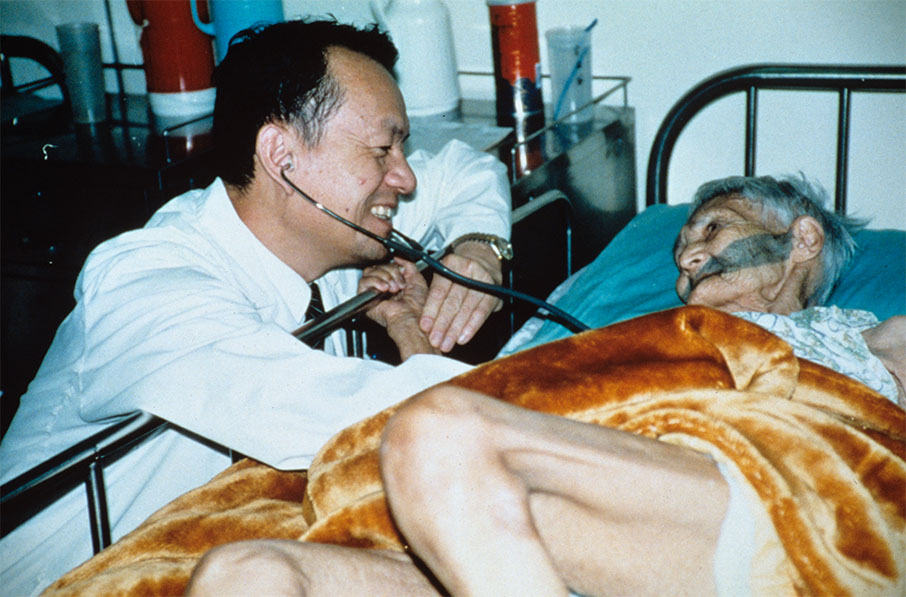
There is a strong philosophy that sustains the Tzu Chi medical mission. Prior Chief Executive Officer of the Buddhist Tzu Chi Medical Foundation and its previous Board Director, Dr. William Keh, describes the people-centric doctrine through which it was founded as such:
[The mission] is based on Master Cheng Yen’s concept of putting people first. We are not only treating the symptoms… we are treating people’s hearts.
Dr. William Keh
Former Chief Executive Officer
Buddhist Tzu Chi Medical Foundation
Stephen Huang, an American businessman, had visited Dharma Master Cheng Yen in Hualien, and meeting this gentle nun, who created a powerful organization and realized seemingly impossible dreams, all for the benefit of others, changed his life. He became a disciple and vowed to bring the spirit and mission of Tzu Chi to the United States, becoming Tzu Chi USA’s first CEO, the Executive Director of its first free clinic, and current Executive Director of Global Tzu Chi Volunteer Affairs.
The persistence and hard work that previously characterized Huang’s approach to his career serve him well in his endeavors with Tzu Chi. He traveled far and wide to nourish the humanistic spirit and ideals of Tzu Chi among communities, trusting in Dharma Master Cheng Yen’s teachings for support throughout this process. Today, Stephen Huang continues along Tzu Chi’s Bodhisattva path.
Dr. Chinlon Lin, now based in Taiwan, and heading Tzu Chi Taiwan’s medical mission, was likewise a pioneer leading the early history of Tzu Chi’s medical mission in the United States. A medical student who came to the U.S. more than half a century ago to study, Dr. Lin became a renowned authority in cardiology during his time in the States, working his way up to President of Dignity Health – Northridge Hospital Medical Center in Los Angeles, and was the first Asian-American president of the Catholic hospital. As might be expected, Dr. Lin became well-versed in the strengths and weaknesses of the American healthcare system, explaining, “Health care in the U.S. is very advanced, one of the most advanced in the world. Germany and the United States are still leading in terms of healthcare. But health care in the U.S. also isn’t balanced, so the ones with good financial conditions have access to the best health care in the world. But others, especially those less well-off, don’t have access to the best healthcare specialties; that’s especially true of the uninsured. That’s why we must have free clinics. People who don’t have insurance will go broke if they are hospitalized to have their appendix removed!”
When his father was sick, and he returned to Taiwan to visit his family, Dr. Lin learned that a Buddhist nun had built a hospital in Hualien. “I was curious,” he shared. “When I visited my family, I thought I’d stop by and see what was going on. I worked in a Catholic hospital in the US, and there were many Christian hospitals nearby. But my personality and cultural background were more in tune with Buddhism, which teaches faith, willingness, and action, but generally speaking, there’s less action. I was very touched by what I saw, and I said ‘yes’ to Master Cheng Yen’s invitation to join Tzu Chi.”
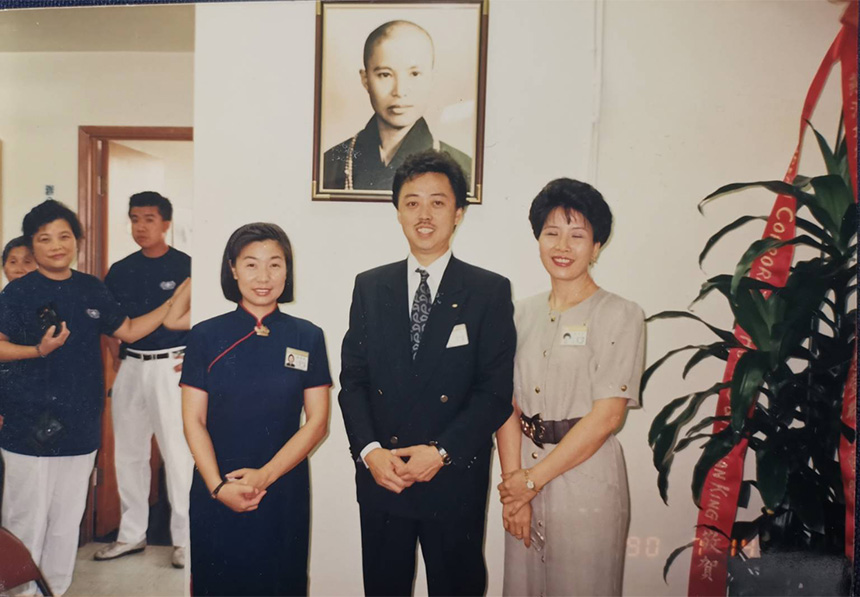
However, they were equipped with no experience and no knowledge of the appropriate laws and regulations. The tasks of recruiting professionals, remodeling the interior for medical use, applying for a license, and reaching out to the community to invite patients were all huge ones. It was anything but easy for an overseas Buddhist organization to set up a local medical clinic in the United States.
In 1992, Emily Chu, a volunteer who was about to establish Tzu Chi USA’s Orange County Service Center, led volunteers to a Catholic church and the Share Our Selves (SOS) Medical Clinic in Santa Ana, trying to absorb the experience of other organizations as a template for office operations. She learned that SOS provided two primary services: Free medical care and food distribution. The director told Chu that besides helping under-represented communities with health conditions, SOS provided food, distributing 300 bags daily to people in need of support, and kept a log of those who received this aid. The non-profit’s free medical services included Western medicine, dentistry, obstetrics and gynecology, and psychiatry; it also helped those in need with their utility bills and rent. Impressed, Chu memorized all their services by heart.
After helping distribute blankets and packing food for community members, the volunteers took a group photo in front of the SOS office to remember this meaningful moment. Little did they know what wonders this spontaneous photo would lead to. When Stephen Huang saw it, he asked Chu what the place was, and she explained in detail. After listening with great interest, Huang told her enthusiastically, “I’ll invite Dr. Chinlon Lin to come over and see if Tzu Chi can set up a free clinic center.”
Following a meeting with SOS, Huang completed a brief evaluation and immediately took the lead, donating his house and motivating volunteers to raise funds. The team started from scratch in terms of funding. In those days, many Tzu Chi volunteers were crafty women skilled in “cooking without rice.” Moreover, although they had little in their pocket, they adhered to Master Cheng Yen’s teaching of “faith in selflessness, faith in the love of others.” They searched for healthcare professionals with confidence, and moved medical volunteers to join and serve with love. During the following preparatory period, Emily Chu helped with everything from bricks and tiles to tables and chairs. On one occasion, they were lucky enough to discover an excellent deal, and purchased multiple desks and filing cabinets. A group of nine people, eight men alongside Chu, who described herself as “a little bit old, but not too old,” transported the goods to the building. Huang sent volunteers to various free clinics to learn more as well. The team held hundreds of meetings, and several architects visited the site for interior decoration.
At the same time, Dr. Lin was working on getting a government license. “To apply for a free clinic, you need the state’s approval, so we hired a consultant to help us with the applications,” he explained. Lin then recounted what happened next in detail: “When the consultant came and said, ‘We can do the application for you at $1,800 minimum,’ we explained that we were just amateurs, non-profit, and didn’t have a lot of money. We bargained and negotiated, lowering the consultation fee to $1,200. Later, he got the paperwork together and delivered it to us. We were finishing up our interior fixtures and decorations at the time. He saw that we put up a sign that said ‘Tzu Chi Free Clinic,’ and asked me about it. I said, ‘We don’t charge the patient for seeing the doctor; it’s free.’ He then asked, ‘What about blood tests and X-rays?’ We told him that the blood test center is across the street and we will pay the lowest price to the test center, but the patients don’t have to pay.’ He was like, ‘Are you serious?’ He thought about it for a long time, and then he said that he would donate the $1,200 consulting fee as well. Great virtue is never alone; it is bound to find support.”
For the sake of the selfless vision, the volunteers strode onward without hesitation, but just before the evaluation, there was a major hiccup.
Dr. Lin continued the story: “One month before we were to open, the state government was supposed to send officials to check if the rules were followed: Can the door frames allow wheelchairs through, there must be hot water. But a month before the evaluation, our new head nurse and the administrative personnel we hired were under a lot of pressure. They went into hiding and disappeared. It was okay that they weren’t there, but they took all our applications with them. We didn’t have computers at that time. The documents were all printouts. We asked Sister Debra Boudreaux for help; she is the current CEO of Tzu Chi USA. I and Mrs. Lin went to Northridge Hospital and borrowed their Standard Operation Procedure (SOP), which was used as an example.”
Debra Boudreaux also remembered that period as a marathon. After work, she rushed to the free clinic, sprinting day and night: “We typewrote from 6:00 PM until midnight,” she reflected. The documents, which would ordinarily have taken three to four months to complete, were ready in just a few weeks.
Finally, with everyone’s concerted efforts, the Buddhist Tzu Chi Free Clinic was approved and ready. It could officially open its doors and begin to provide services for the San Gabriel Valley community in Southern California, which it does to this day.
Crafty Women to Carry It Forward
“In 1993, we were members of Doctors Without Borders,” said senior nursing volunteer Meizhao Wu, “and every year, we would go to Monterey Park in California to volunteer at the emergency station for the Mother’s Day celebration. At that time, there happened to be a cardiologist, Dr. Guoxing Ye, who told us that Tzu Chi was opening a free clinic. So we, which included Dr. Ye and a few nurses, went to check it out.” When Wu first went to the free clinic, she saw a small but strong team: “There really weren’t a lot of people, just Sister Debra Boudreaux and Emily Chu in the office to run the administration, plus a nurse and a pharmacist. Whoever was available would come and work the shifts.”
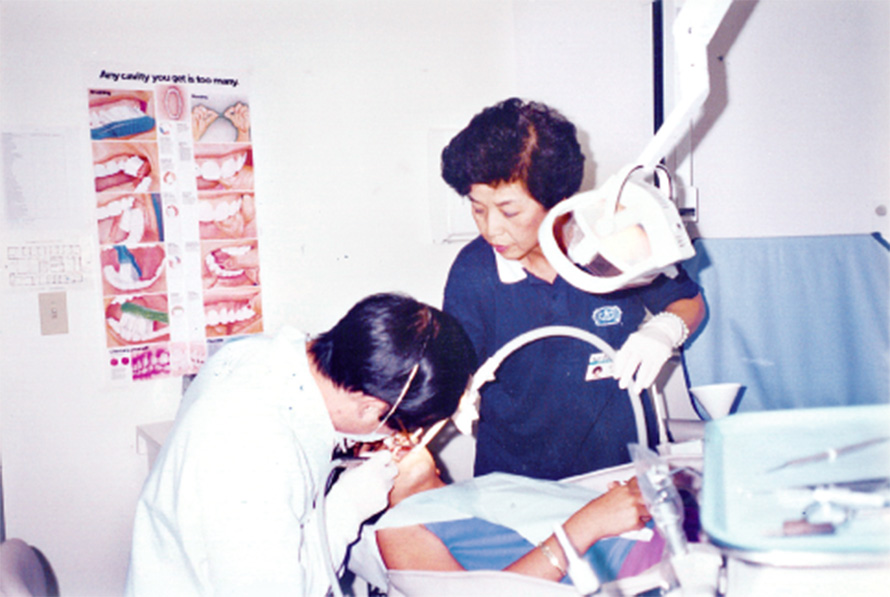
“When we opened, we relied on volunteers in three departments: Internal medicine, dentistry, and Traditional Chinese Medicine,” said Dr. Chinlon Lin. At that time, there were also Ear, Nose & Throat and ophthalmology services, but because the equipment was not yet fully in place, these two disciplines were carried out in the volunteer doctors’ clinics to compensate for the needed staffing, funds, equipment, and space.
The clinic also did not always have enough of certain medications then, so everyone reached out through different approaches to fill the need. “For example, where did the pharmacy department get the expensive medicines? Pharmaceutical companies have drugs that are near their expiration date; they can’t sell them to pharmacies, because if they are put on the shelves and then later sold to patients, the drugs may have expired. So our volunteers went and asked for big jars of medications that contained 1,000 pills, and then divided them into small packets so that we could provide the drugs free of charge while the medications were all within the expiration date,” Lin said, smiling at the resourcefulness of his team at the time.
I went to other clinics to collect medication samples I knew had been provided by pharmaceutical companies to doctors I knew. If you don’t collect these medicines, it’s a waste if they are not used. These are the medicines that could be used at the clinic. It’s just a matter of going and getting them.
Meizhao Wu
Senior Nursing Volunteer
Buddhist Tzu Chi Free Clinic
“Just do it! That was our way!” Meizhao Wu explained. She and all the volunteers were not afraid of challenges and believed that overcoming them was part of their job. “Dr. Chinlon Lin did everything in the early days; although he was the director, he did everything that a doctor should do by himself, and I admire him for that,” Wu said, adding, “Every one of the volunteers was doing this without complaint if it was something we could do. As long as others needed it and we could achieve it, we would do it.” Wu, who is over eighty years of age at present, spoke with emotion about that period of hard work 30 years ago. “Many volunteers made me feel very touched. For example, Sister Nancy Chou would scrub the floor herself when a patient got sick. There was also Dr. Youxiao Du, who would do everything himself. Regardless of their roles as doctors or otherwise, these people were not afraid to roll up their sleeves for the sake of their patients; they just did everything themselves. As long as I’m here today, I’ll clean these things up, so that the patients can recover and be happy.”
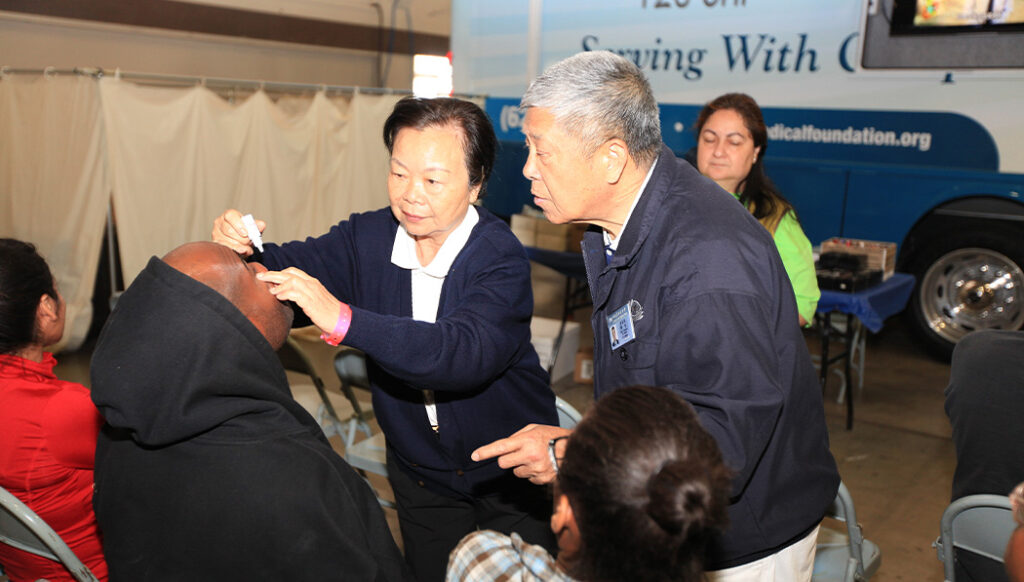
I remember when I gave my speech on the day of the opening 30 years ago. I told everyone that this Tzu Chi Free Clinic is the result of the love of many people, and that this love will be passed on from generation to generation.
Dr. Chinlon Lin
Medical Director
Buddhist Tzu Chi Free Clinic
Led by Dr. Chinlon Lin, the medical mission’s team in the USA took its first steps forward. Although it was not easy, because of the team’s love, dedication, and professionalism, it has received several awards since its inception. “There’s also recognition from the Los Angeles government. You see, we, as immigrants, came from other countries and used the resources from the more powerful country, the United States — green cards, SSNs, and health care. We are the first immigrant Buddhist organization to give back to the local community. We received so many awards and medals because they felt our love. Master said, ‘We have to give back to the local community when we set foot on other people’s soil.’”
Section 5
Stride Onward With Love and Relief
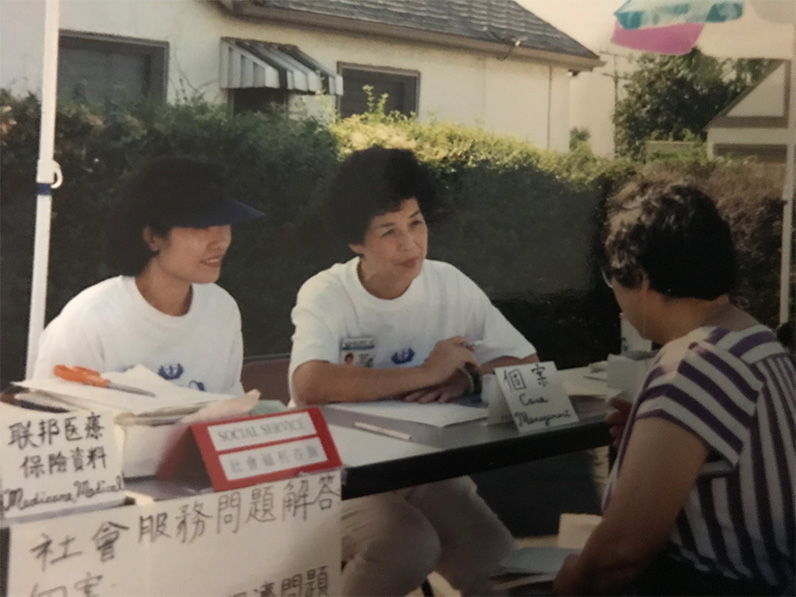
The first Tzu Chi medical clinic in the United States opened its doors to the community on November 1, 1993, to provide free healthcare services to local residents, officially registering on December 28 of the same year.
In essence, each component of Tzu Chi’s medical mission has compassion at its core, guided by the Buddhist principle of interdependence — the understanding that the behavior and attitude of every person involved, as well as aspects of building design and caregiving procedure, contribute to the whole.
As word spread, the number of patients visiting the clinic grew rapidly. By the end of September 1995, the clinic had received an astonishing 10,280 patient visits. During the clinic’s first year of operation, from November 1993 to September 1994, it had welcomed 3,600 patient visits. However, the clinic’s growth didn’t stop there. Over the following year, from October 1994 to September 1995, the number of patient visits rose to 6,680, representing a soaring growth rate that would only continue to flourish with Tzu Chi’s missions. Since 1993, Tzu Chi’s medical services have expanded from a single free clinic to three permanent health centers and a fleet of 12 mobile clinics, further strengthening its ambition to support healthy communities.
Today, the Buddhist Tzu Chi Health Center in Alhambra, California, is a medical, dental, and acupuncture health center serving Alhambra and surrounding communities – including Los Angeles, Monterey Park, Rosemead, Pasadena, San Gabriel, South San Gabriel, Temple City, Montebello, El Monte, South El Monte, and Arcadia.
Adding to the impact and value of Tzu Chi’s medical mission in the United States, in 2020, Tzu Chi USA’s three health centers in California (in Alhambra, South El Monte, and Wilmington) were certified as Federally Qualified Health Center Look-Alikes, enhancing Tzu Chi’s capacity to deliver quality health care to neighboring communities. Tzu Chi’s Health Center in Alhambra accepts Medi-Cal, Medicare, and most health insurance plans, and is also known for its compassionate care and affordable Sliding Fee Discount Program.
Working in collaboration with global, national, and local partner organizations, healthy communities across the U.S. become possible, and public health awareness becomes more robust. Collaborating with other community groups, the Tzu Chi Health Center in Alhambra holds a Tzu Chi Community Health Fair twice per year, providing health education, free flu shots, mammograms, and other screenings to community residents. When Tzu Chi established a Cancer Support Group and Hepatitis Support Group, it allowed patients to form a community. And doctors in those fields meet with families, enabling them to share their experiences and concerns, offering a truly valuable space for support during difficult times.
The Buddhist Tzu Chi Medical Foundation pays particular attention to meeting the healthcare needs of underserved populations. In California, its mobile clinics provide a special focus on care for migrant farmers throughout the central region, while the health centers provide a home base for treating more complicated cases, such as minor surgery or chronic diseases with complications. Tzu Chi USA’s mobile clinic services also extend beyond California. In New York and Las Vegas, Tzu Chi Mobile Clinics address vision and dental care needs in medically underserved communities, with special efforts focusing on schoolchildren.
Through its three Tzu Chi Health Centers (Alhambra, Wilmington, South El Monte), 12 mobile clinics, and medical outreach events, Tzu Chi Medical Foundation offers dental, medical, acupuncture, vision, cancer screening, and community health services. The health centers serve over 150,000 visits per year, while medical outreach and mobile clinics serve over 100,000 visits annually. In 2022, a total of 79 domestic medical outreach events were organized nationwide for local residents to obtain much-needed treatments and free medication for those who can’t afford them. This outreach is made successful with the support of local partners, 622 medical professionals, and 1,763 general volunteers.
